Main Menu

Tornister (Backpack)
Infantry Backpack
Model 1895 (Tornister 95 or
Tornister 96 in Bavaria)
By Randall Chapman and Curt Schmidt, JR63
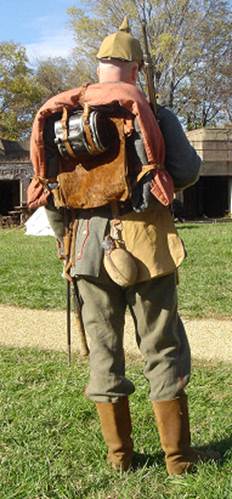
Before the war, the model 1895 Tornister was light brown in color, bordered with tan leather, and the front and back were topped with fur-covered calf-skin or horsehide. During the war, as demand outstripped production ability, construction in all canvas and incorporation of Ersatz materials replaced the hide and leather. The framework was made from wood and was lined with a waterproof canvas. In addition to the main pack body, the backpack flap contained a compartment for storing clothes and two compartments for holding rifle cartridges. In the top of the pack attached a canvas bag containing tent accessories.
The backpack was carried using two main leather suspension straps, which were attached with special quick-release bolts at the top of the backpack. These ran over the shoulders and down to the belt and united with the D-rings on the back of the ammo pouches using adjustable hooks. Each leather strap contained a smaller auxiliary strap, fixed on a movable pivot. These smaller straps were adjustable and run under the armpits and looped over hooks on the underside of the main pack body - it is these auxiliary straps that bear most of the weight.
In addition to the adjustments on the auxiliary straps, the main
leather straps have two forms of adjustment: the quick-release bolts
could be removed and the strap moved upwards and downwards and the
hooks on the opposite end could also be adjusted up and down. In
addition to the various adjustments, the packs were also
delivered in three sizes, having heights of 29.5 cm
(11.6"), 31.5 cm (12.4") and 33.5 cm (13.1"). The
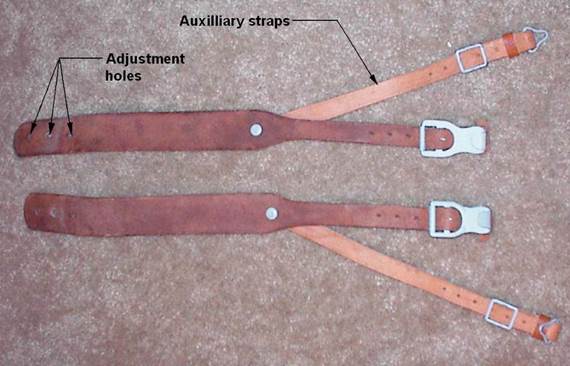 packs were offered in various sizes and with the above adjustments
because regulations prescribed that the backpack should be in close
fit with the man's back. However, this had certain disadvantages:
during the summer it produces excessive heat while during the winter
there was the possibility that - during rests - the back of the
backpack became wet and the soldier could get sick.
packs were offered in various sizes and with the above adjustments
because regulations prescribed that the backpack should be in close
fit with the man's back. However, this had certain disadvantages:
during the summer it produces excessive heat while during the winter
there was the possibility that - during rests - the back of the
backpack became wet and the soldier could get sick.
Main pack straps detached from the pack
Packing the Tornister
In this article I have attempted to prepare a practical and realistic photo guide for packing a WWI Tornister for the German reenactor. I collected various reference materials containing information for packing Tornisters but they were different and conflicting. Therefore, I relied primarily on contemporary sources, combined selected information from other sources, and threw in a little experimentation to arrive at this guide. Preparing this guide using all original items and perfect reproductions would have been ideal, but since such things are not available, I have instead chosen items that most reenactors should have access to. These items include a number of post WWII European surplus, various Civil War reproductions that are close to WWI period in appearance, as well as some possibly questionable WWI reproductions.
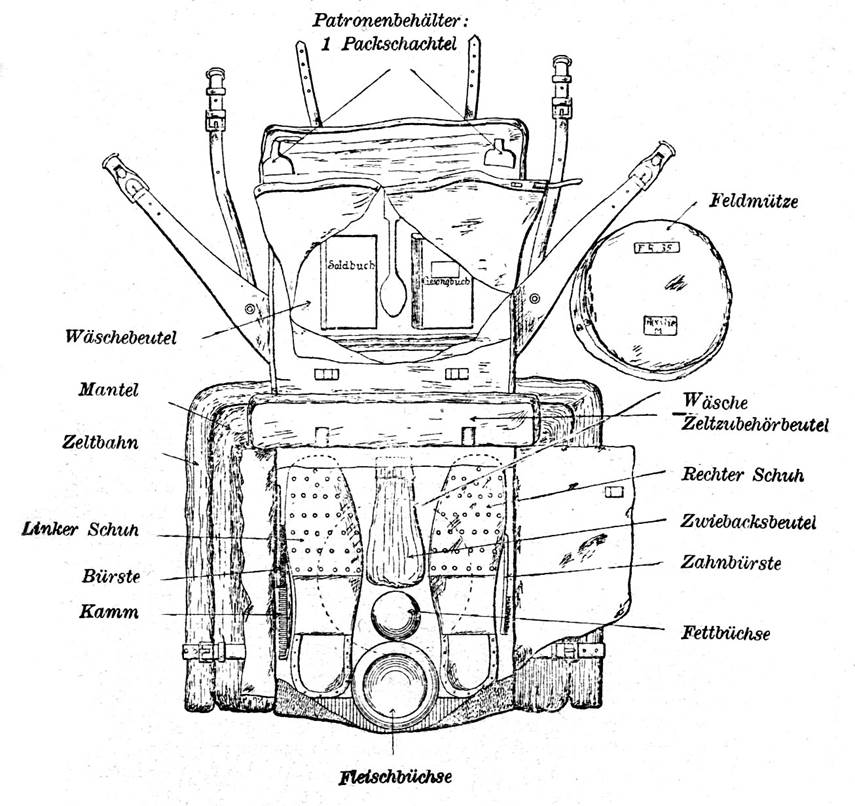
Original illustration for one method of packing
the Tornister
from
Major Wenzel's Dienstuntericht
des Deutschen Infanteristen
by Eckart Von Wurmb
Contents of the Tornister
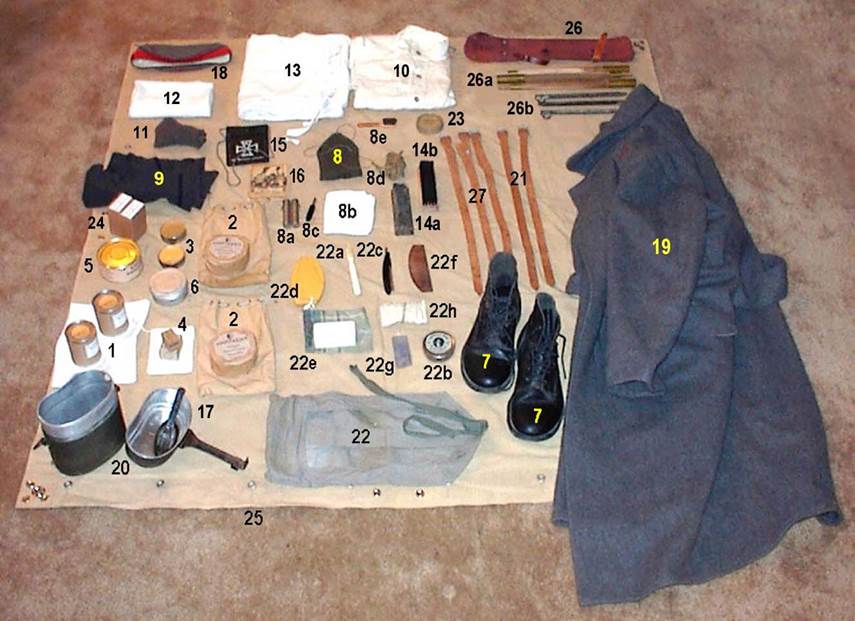
Above find all of the contents listed below, laid out on top of a Zeltbahn.
A Tornister, packed according to regulations, would contain the following items:
- One package with two rations of preserved vegetables (Gemüsekonserve) 300g (10.7oz), 9cm W x 12cm L x 2cm H (3.5"W x 4.7"L x 0.8"H). Since modern vegetables do not come in flat rectangular packages, I used re-labled 8 oz round vegetable cans. They were inserted into a linen bag (ie. one package).
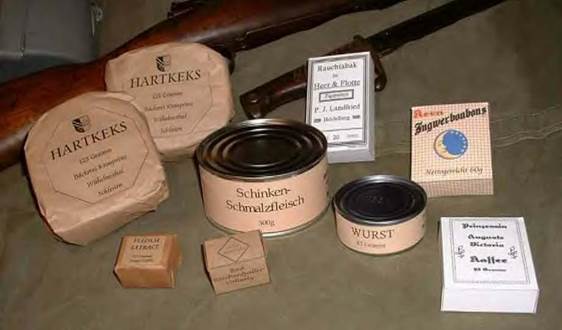
- Two bags of rusk 500g (17.6 oz) (Zwiebacksäcken) - "Hartkeks" from the repro "iron rations" packed into small canvas draw-string bags.
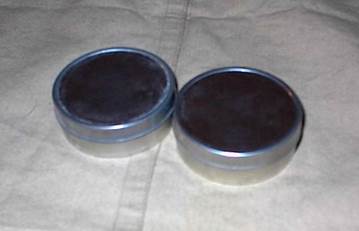
- Two cans of coffee 50g (1.8 oz): A round tin 6.5cm diam. x 2.2cm H (2.6"diam. x 0.9"H) with a friction fit lid. According to a Prussian decree of April 12, 1916, the tins were to be made of unpainted, non-tinned sheet-iron, which was also mandated in Bavaria on April 26, 1916. The tins formed a light rust and the coffee flavor could be affected.
The cans in the photo, while being nearly the correct size, are unfortunately tin-plated
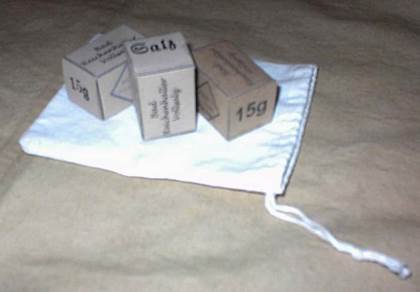
- Bag of salt 50g (1.8 oz), 10cm W x 20cm L (3.9"W x 7.9"L). The 10cm wide and 18cm long salt bag was composed of cloth and was adjusted with laces. Due to a lack of cotton during the war, the Prussian War Department introduced a bag made of papercloth on October 8, 1917. The bag had to be prepared from pure rag paper of an inconspicuous color; it was closed by two 20 cm long and 1 cm wide woven paper laces that were sewn into the side seam on the upper edge. Bavaria accepted the bag on October 23, 1917.
For this exercise, I am using the reproduction "iron ration" salt portion - (3) 15g boxes in a linen, draw string pouch
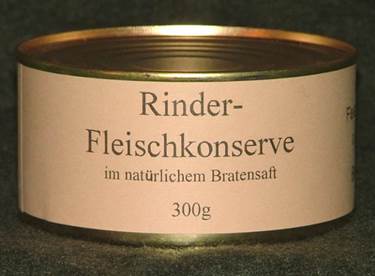
- One package with two rations of canned meat (Fleischbüchse) 400g (14 oz) - For this exercise I am using the reproduction "iron ration" meat can - one can of 300g (10.6 oz).
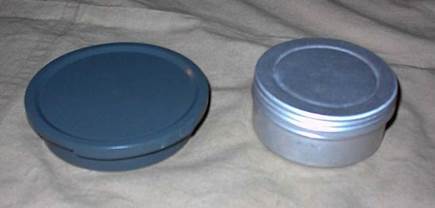
- Fat Container (Fettbüchse) - I am using an original 1917 dated dish filled with chicken Schmalz. The Germans, as I hope you know, ate Schmaltz (seasoned goose fat preferably, or other animal fat) rather than butter; at least they did during the Wilhelmine era.
Photo shows the Schipperfabrik Fettbüchse on the left painted in Feldgrau, and an original aluminum screw-top version dated 1917.
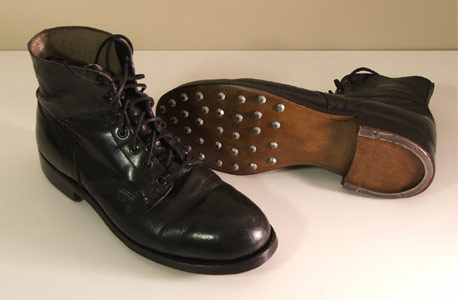
- A pair of ankle boots (Schnürschuhe) - I am using a converted 1950's Swiss pair.
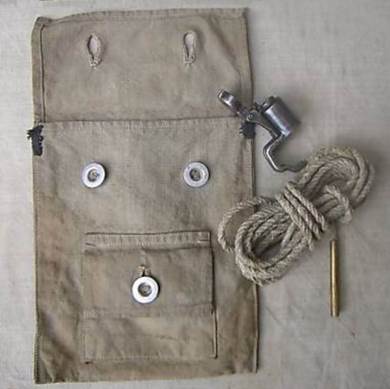
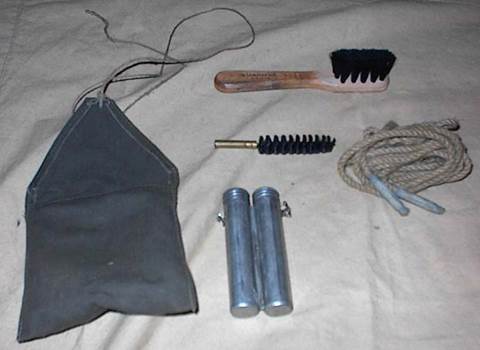
- Rifle cleaning materials were stored in a
bag (Gewehrreinigungsbeutal) - an original is pictured at left
with pull chord and post-WWI muzzle cover. I am using a
European surplus pouch (probably Swiss 1940's). This bag might contain:
- Each soldier would have carried 60g of rifle grease (Gewehrfett) in an oil tin that consisted of two tinned steel cylindrical containers fitted one inside the other. A lid with a paper washer sealed the 5.7 cm high by 4 cm diameter outer container in order to diminish the rattling of the inner container. The 5.4 cm high by 3.5 cm diameter inner container consisted of a gasket made of cork or of conditioned chamois leather in the screw-top lid. For this exercise I am using an old European surplus tin with two compartments, one containing cleaning solution and the other containing gun oil.
- Cleaning cloth (Putzlappen) - I am using a commercially available cotton cloth
- Bristle - I am using a bore brush that is threaded to fit the GEW98 cleaning rod
- Wiping/Pull chord (Wischtrick) - came with the Swiss pouch.
- Grease brush (Fettbürste) - European surplus. This brush is very similar to one sold by GWM as part of an original gun cleaning kit (below).
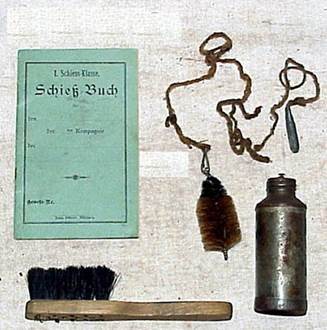
Note: These cleaning materials may have also included tow (Werg), but I have not included tow in this exercise. "Tow" is unspun linen fibers. The fibers of the stalks are combed and processed several times until they come out like fine blond hair. For centuries, until the rise of the modern production techniques where cotton cloth was cheaper than tow linen, tow was used as a cleaning swap for black powder and then smokeless arms. It was also used as a convenient packing medium for shells and explosives in their wicker or wooden crates (which might be why soldiers seem to have had good access and availability to it). It rinses out well, and dries, for reuse.
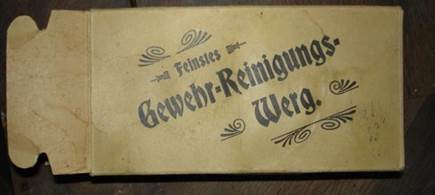
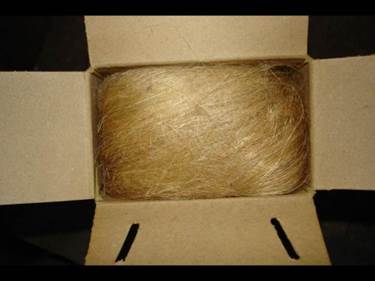
Above: Two views of a package of "Werg" - most likely post-WWI
- Wristlets (Pulswärmer) and toque (Kopfschützer). Here I have packed a scarf (Halstuch), but this could have easily been a toque and pair of gloves (or 'wristlets')
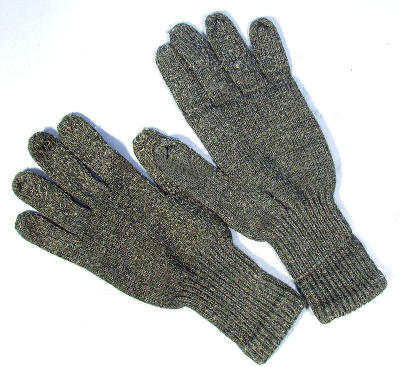
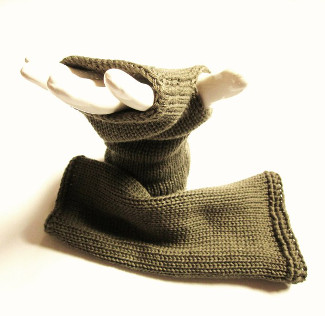
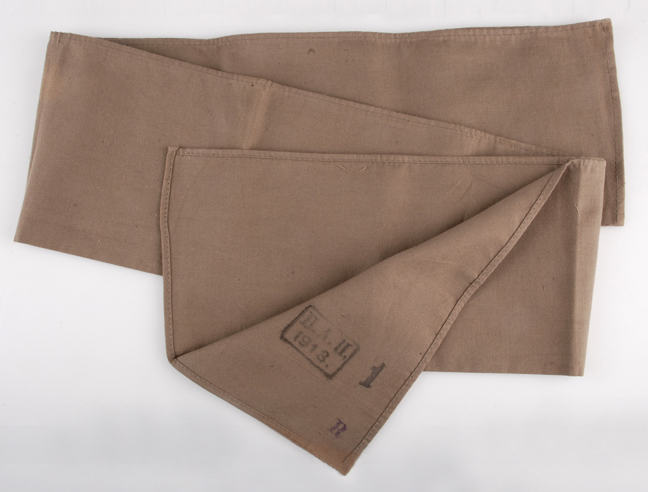

- One shirt (Hemd) - A typical reproduction
- One pair of socks (Strumpfe) or foot cloths (Fußlappen) - I used wool socks
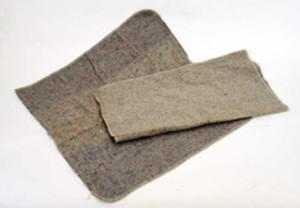

- One handkerchief (Taschentuch) - Plain old cotton handkerchief
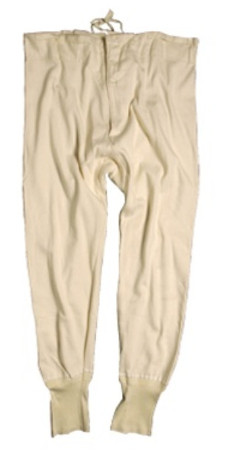
- Underpants (Unterhosen), only in winter - A Schipperfabrik reproduction
- Other cleaning materials (Putzzeug) were stored in the backpack as well:
- Clothes brush (Kleiderbürste) - European surplus (1950's Swiss most likely)
- Shoe brush (Stiefelbürste) - came with the clothes brush.
I used European surplus brushes, and they do appear very similar to those in this original photo below.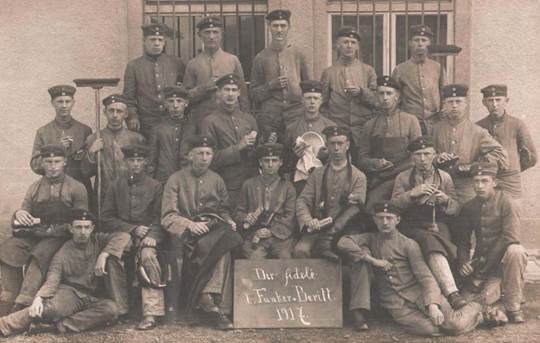
- Messing cleaning materials (Messingputz) - I did not include these, I was unable to ascertain exactly what these cleaning materials would have consisted of.
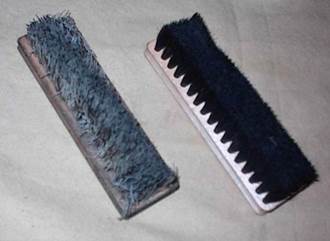
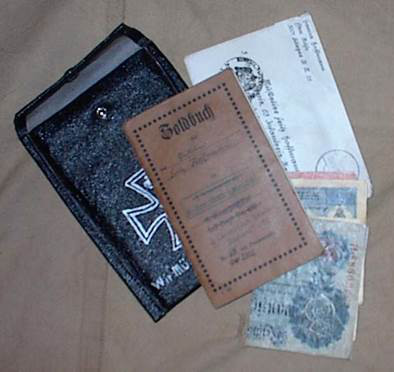
- Soldier's paybook (Soldbuch) - Reproduction book and oilcloth wallet.
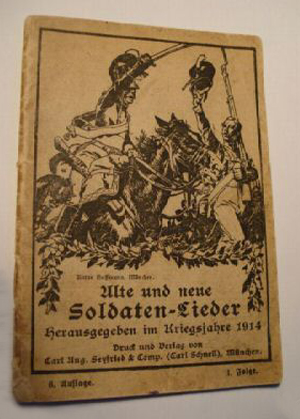
- Song book (Feldgesangbuch) - An original dated 1915.
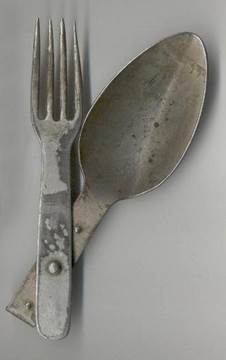
- Spoon (Löffel) & Knife (Messer). For our purposes these items have been replaced with an original tinned steel spoon/fork utensil (Eßbesteck)
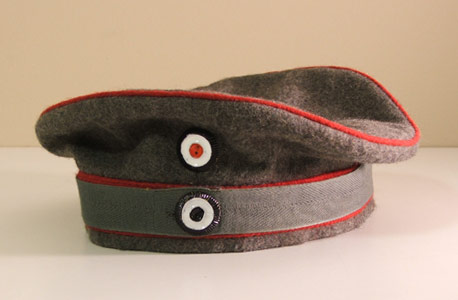
- A field cap (Feldmütze) - A GWM Reproduction
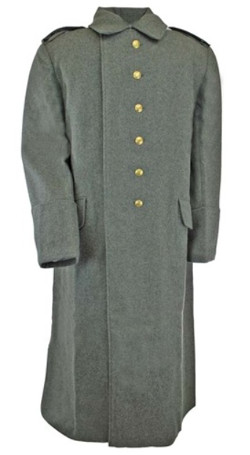
- Overcoat (Mantel) M1907 - Reproduction
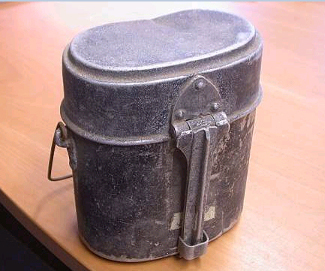
- Messkit (Kochsgeschirr) - an original M1910 Aluminum
- Messkit straps (Kochsgeschirriemen) of 55 cm (21.7") in length
- Toiletry items (Waschzeug), I am using the repro "housewife"
by Steve Fisher.
- Toothbrush (Zahnbürste) - a Civil War reproduction bone/natural bristle brush
- Tooth powder - another Civil War reproduction
- Razor (Rasiermesser) - I used an original 1920's German straight razor
- Mirror (Spiegel) - and another Civil War reproduction
- Soap (Seife) - stored in a linen bag - I used the repro soap by Schipper which is nearly identical in size and shape to an original bar in my collection - in the photo, the original bar is the darkened bar positioned above the Schipper bar.
- Comb (Kamm) - you guessed it, a Civil War reproduction wood comb
- Sharpening stone - not an issue item, just something I carry in my 'housewife'
- Sewing kit (Nähzeug) - Civil War reproduction canvas pouch with Feldgrau and Steingrau thread, wool patches, needles and extra buttons
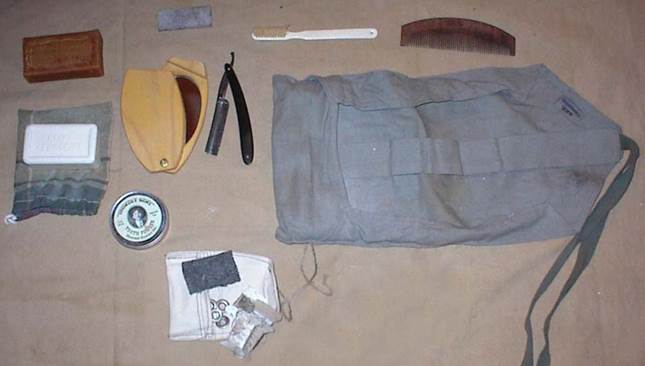
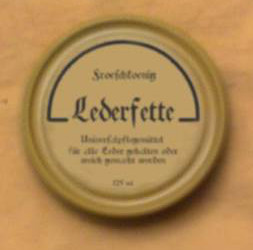
- One can of dubbin (Lederfett): a dull, waterproofing wax compound for leather. I am using a commercial can of leather conditioner, painted and re-labeled.
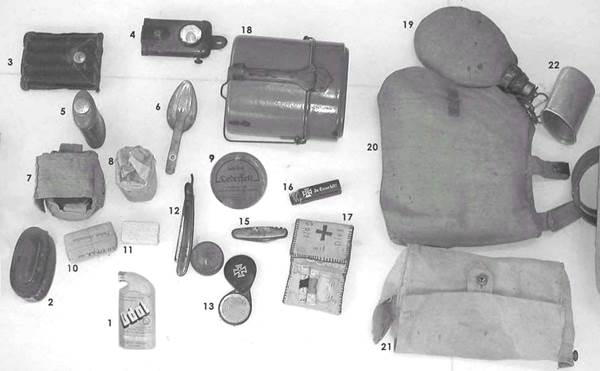
I copied the basic design of a can of dubbin (Lederfett) from this original photo of a Soldat's personal items (Item 9) - the color was mere speculation.
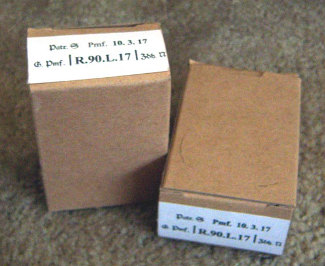
- Spare cartridges (30) boxed in two reproduction boxes
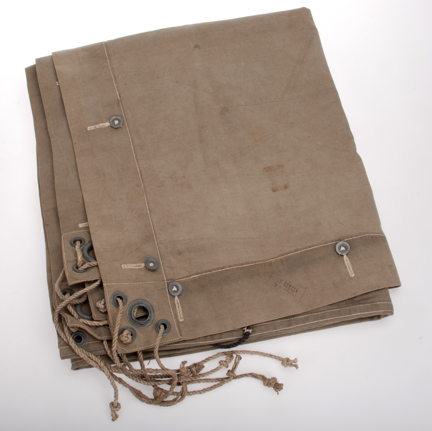
- Tent Quarter (Zeltbahn) - A Steve Fisher reproduction
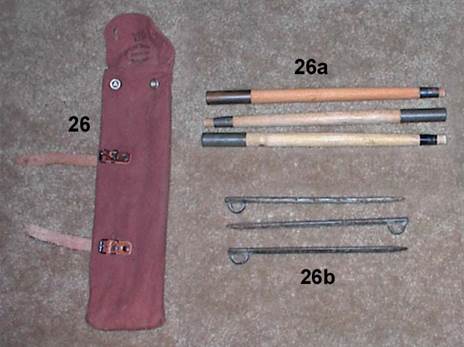
- Tent accessories (Zeltgräte) were stored in a
canvas bag (Zeltzubehörbeutal), it contained:
a) Three tent poles (Zeltpflöcke) - GWM reproduction.
b) Three tent pegs (Zeltstöcke) - Steel originals marked 1915.
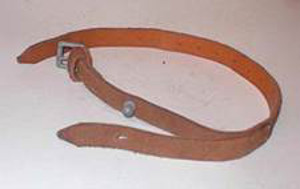
- Mantel roll/Zelt straps (Mantelriemen). Pre-war straps came 43 cm (16.9") long, but the length was increased 53 cm (20.9") in 1915. These straps had an additional smaller strap sewn in the middle of the base straps, pointing towards the buckle and secured by means of a stud.
Packing the Tornister
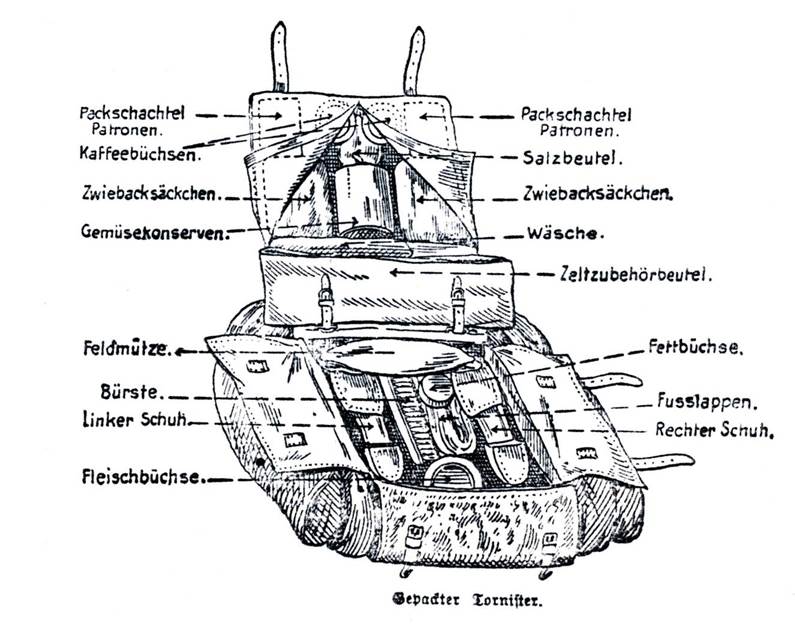
Original illustration for another method of packing the Tornister from
„Der Feldgrau" Leitfaden für den Dienstuntericht des Infanteristen
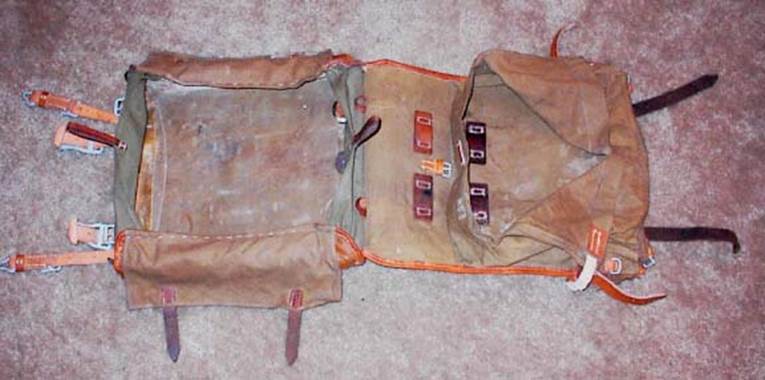
Unpacked and open Tornister
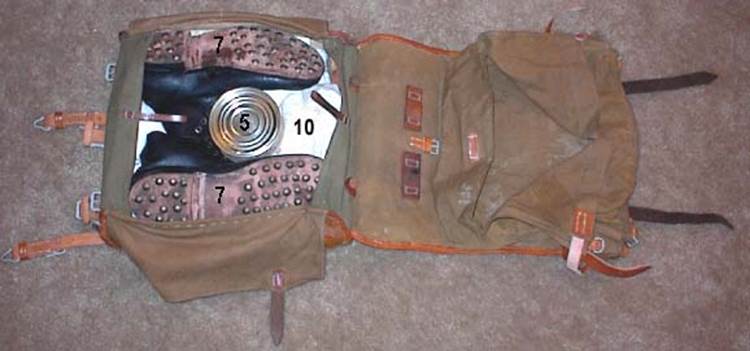
To pack the Tornister, a
shirt (Hemd) [10] is first laid out
flat on the bottom of the main pack body. The low boots
(Schnürschuhe)
[7] are placed to the right and to the left respectively with the soles up, the
ankle shafts turned inward toward the middle. On top of the shirt between the
low boots, is placed the meat can (Fleischbüchse)
[5].
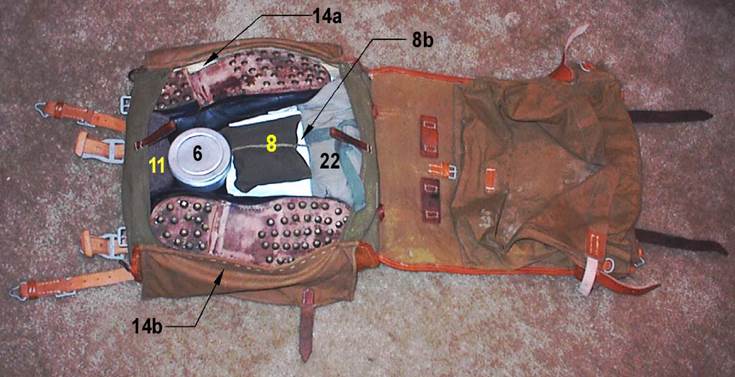
The underwear (Unterhosen) [13], according to one
recommendation, was also to be folded and placed on the bottom of the main pack
with the shirt. The idea being that these linens would provide padding between
the other items and the wearer's back. However, I could not do this, when I
packed the underwear with the shirt, I was unable to close up and buckle this
compartment.
Above the meat can and between the shoes, is laid the polishing cloth (Putzlappen) [8b] with the rifle cleaning supplies pouch (Gewehrreinigungsbeutal) [8] placed on top. The wash kit (Waschzeug) [22] fit nicely in the upper section between the toes of the boots. The fat container (Fettbüsche) [6] fit below the meat can and the socks (Strumpfe) [11], or foot wraps (Fußlappen), were placed in the bottom of the Tornister body below the fat container.
Note: The cleaning cloth (Putzlappen) and sewing kit (Nähzeug) could also be stowed away in the shoes.
The cleaning kit (Putzzeug) was typically carried jointly by 3 or 4 soldiers. For example, one carried the clothes brush (Kleiderbürste), another the boot brush (Stiefelbürste), a third the rifle polishing cloth (Gewehrputzlappen), tow (Werg) and grease brush (Fettbürste), and a fourth the "pull through" cleaning cord (Wischstrick) and sewing kit (Nähzeug). In this exercise, I have packed in all of these cleaning supplies: the sewing kit is in the wash kit [22], the gun cleaning supplies are all in a single pouch [8], the clothes brush [14a] and the boot brush [14b] were slipped between the boots and the outside of the Tornister body.
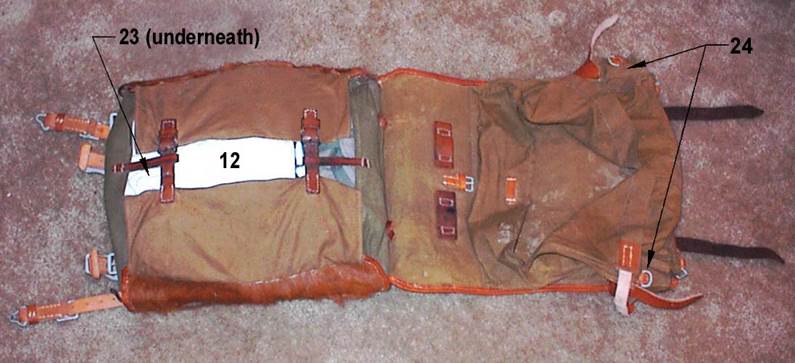
The Dubbin (Lederfett) [23] is placed on top of the
socks and the handkerchief (Taschentuch) [12] is laid out on top and the
pack body flaps can be buckled. The picture also shows the ammunition pockets
that each hold a box of 15 rounds [24].
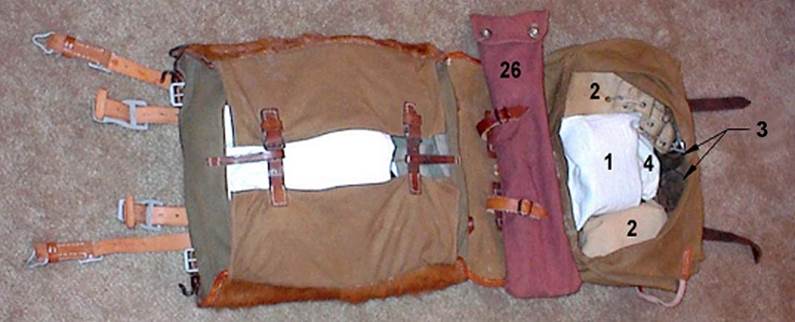
Inside the garment bag (Wäschebeutel), under the Tornister flap, the
two small cracker bags (Zwiebacksäckchen) [2] were first pushed up to the outside
of the ammunition pockets. Two coffee tins (Kaffeebüchsen) [3] were then laid
between them, and against them was laid the salt pouch [4] and the vegetable
ration (Gemüsekonserve) [1]. The Zeltbahn accessory
bag (Zeltbeutel) [26] was fastened on the loops of the upper edge of
the Tornister with its opening to the left.
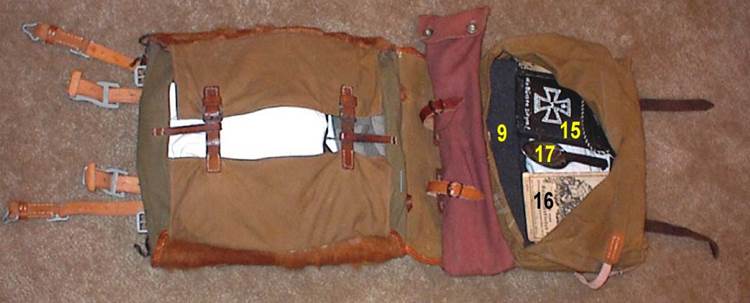
The scarf (Halstuch) [9] (or gloves and toque) were to
be situated in front of the right Zwieback. Here, for balance, I have packed
the scarf along the length of the bottom of the garment bag. On top were placed the pay
book (Soldbuch) [15], Spoon/fork (Eßbesteck)
[17], and the soldier's songbook (Feldgesangbuch) [16].
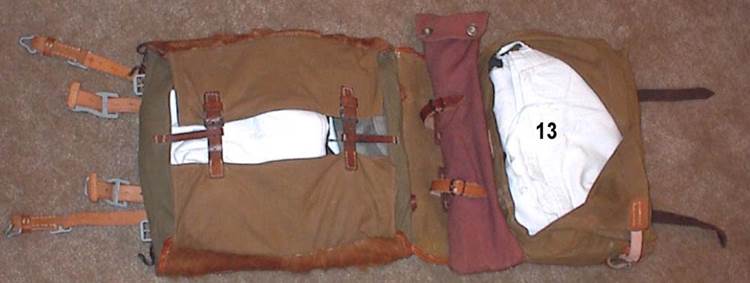
According to other recommendations, the underclothing
(Unterwäsche) [13] should be stored in the garment bag and not in
the Tornister body. I followed this recommendation because they simply
would not fit in the other compartment. This also proved very effective at
holding the books and spork in place once the pack was buckled up.
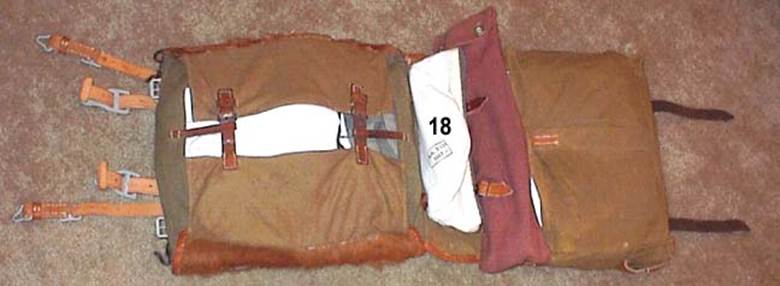
The field cap (Feldmütze) [18] was laid on the buckled
up Tornister body (Tornisterkasten). However, during the
war, it was turned inside out and was stored below the tent accessories bag on
top of the closed central frame of the backpack.
If the soldier was wearing the shoes, he would lay the marching boots (Marschstiefel) with the shafts flat on the Tornister body, so that the soles, with the heels down, were turned to the outside and laid to both sides of the Tornister on the greatcoat (Mantel) and shelter half (Zeltbahn) roll.
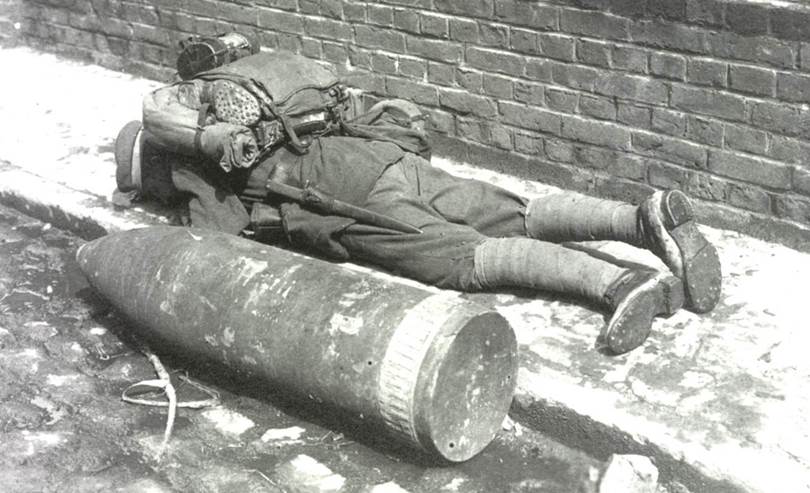
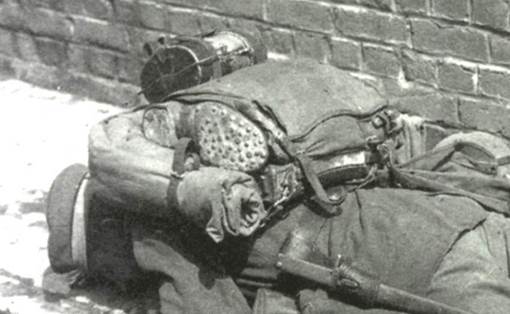
This strange original photo shows a soldier in his low boots and Gamaschen with his Marschsteifel packed into his Tornister - although with heels up.
Mantelrolle (Folding of the Overcoat)
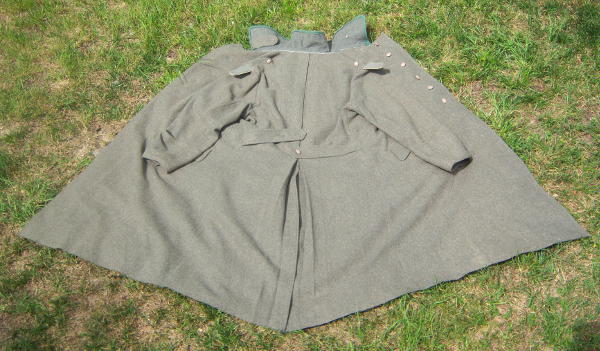
The overcoat is laid, inside down, on the floor. The shoulder straps and the
rear belt are unbuttoned. The tail vent is buttoned (this was not done for this exercise -
the tail vent on the Schipperfabrik M1907 Mantel does not have buttons) and the
collar turned up. The coat is fanned out and the sleeves laid parallel to the
edges.
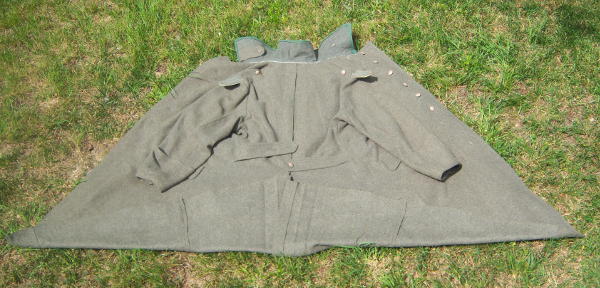
The rounded bottom edge is folded up in order to create a straight edge.
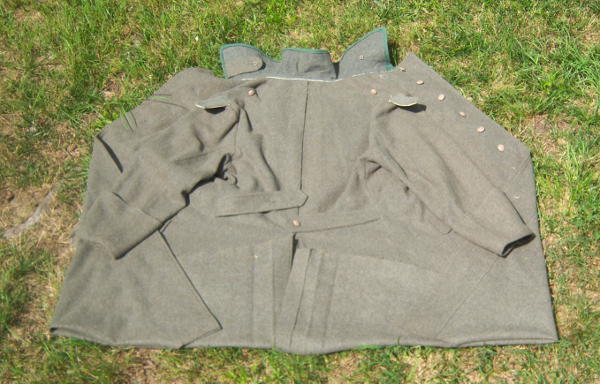
The bottom corners are then folded in to form a squared off effect. The sleeves
are brought out from underneath and folded so that the cuffs are even with the
edges. (I experimented with this step to determine the exact amount to fold in the sides
so the finished Mantelrolle, when strapped to the Tornister, would
have the ends even with the bottom of the pack.)
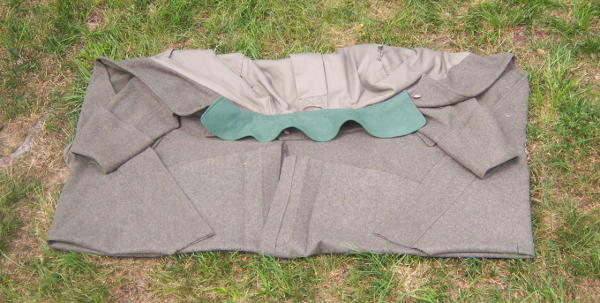
The top collar end is now folded in to a point where the inside arm holes are
visible.
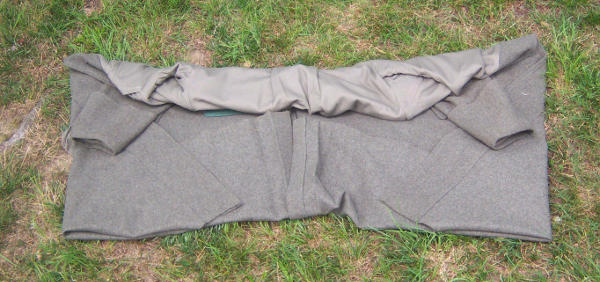
The roll starts from the top by folding the coat over
flat, the width of a hand. This continues until the roll is finished. Folding
rather than rolling gives the proper effect.

The complete Mantelrolle.

Fold the Zeltbahn into 8ths and lay it on top of
the Mantelrolle before you attach the center strap. Attach the
center strap, and then attach to the Tornister.

Zeltbahn/Mantel roll strap. Note the addition of an extra closure
strap on the outside face and the detail of its use. This allowed
the Zeltbahn/Mantel roll to be removed
without detaching the strap completely from the pack and possibly
becoming lost.
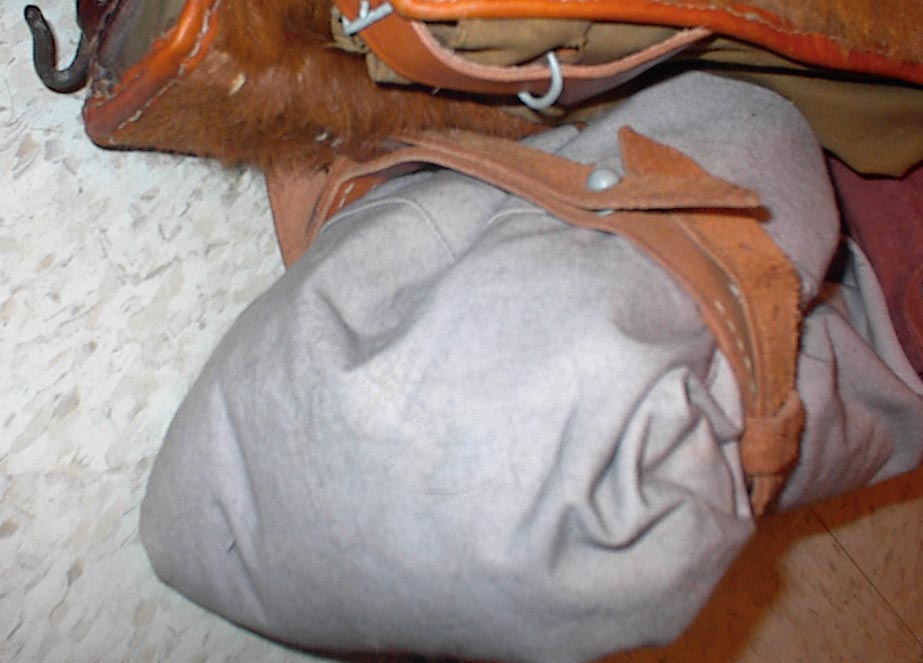
The mess kit (Kochgeschirr) was buckled onto the Tornister flap
with its lid facing to the right. The pointed ends of the buckle
straps, that go from up to down, should point toward the greatcoat.
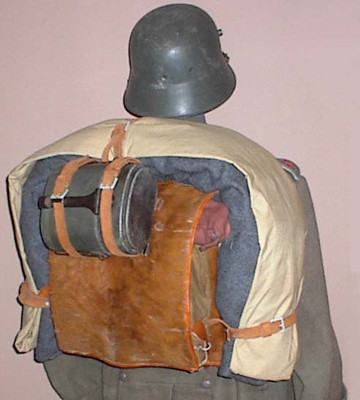
Fully packed Tornister with low boots
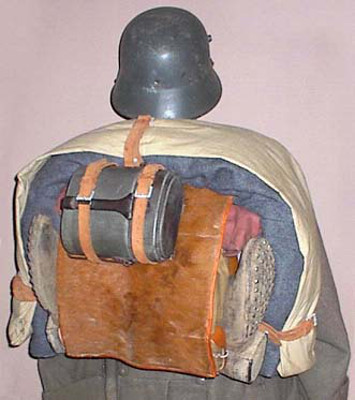
Fully packed Tornister with Marschstiefel
The Zeltbahn
ends are folded to be even with the Mantel roll
and the bottom of the Tornister. If correctly packed, the
Zeltbahn/Mantel roll should be 12-14 cm wide on the sides and 8-10
cm high at the top. The pointed ends of the greatcoat straps should point to
the inside. According to a Prussian decree of October 27, 1914, soon after the
outbreak of war, it was also permitted for the shelter half to be buckled under
the greatcoat for better camouflage.
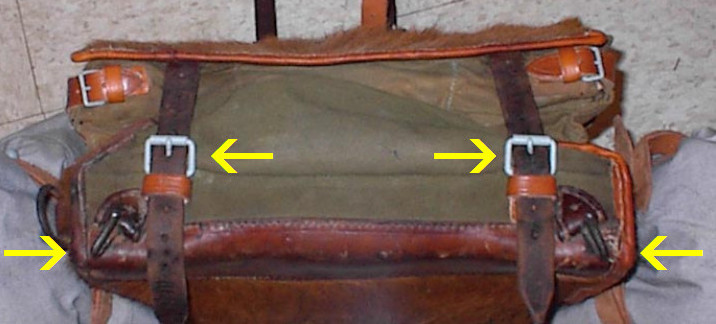
Bottom view of the Tornister pack. Note the auxiliary carry strap hooks mounted angularly at the outside ends, and the main flap closure straps and buckles just inside of the hooks.
Total weight of the pack as demonstrated above:
Tornister (empty - no utility straps)
Messkit straps (Kochsgeschirriemen)
Mantelrolle/Zelt straps (Mantelriemen)
Tent accessories in a bag (Zeltzubehörbeutal)
Overcoat (Mantel) & Tent Quarter (Zeltbahn) Roll
Messkit (Kochsgerschir)
Spoon/fork utensil (Eßbesteck)
Canned vegetables (Gemüsekonserve)
Two bags of rusk (Zwiebacksäcken)
Two cans of coffee (cans weigh 55g empty)
Bag of salt (45g plus a linen bag)
Canned meat (Fleischbüchse)
Fat Container (Fettbüsche) - 147g empty
A pair of ankle boots (Schnürschuhe)
One shirt (Hemd)
One pair of socks (Strumpfe) or foot cloths (Fußlappen)
One handkerchief (Taschentuch)
Underpants (Unterhosen)
Scarf (Halstuch)
A field cap (Feldmütze) - 75g alone, 86g with camo band
Toiletry items (Waschzeug)
Rifle cleaning materials in a bag (Gewehrreinigungsbeutal)
One can of dubbin (Lederfett)
Other cleaning materals (Putzzeug)
Messing cleaning materials (Messingputz)
Soldier's paybook & wallet (Soldbuch)
Song book (Feldgesangbuch)
Spare cartridges (15 rounds per box @ 408g ea.)
TOTAL
1,337g
84g
155g
748g
4,536g
415g
92g
610g
353g
105g
65g
362g
232g
1,143g
358g
61g
63g
432g
186g
86g
463g
156g
49g
206g
0g
98g
28g
816g
13,239g or 29.2 lbs
According to 1908 regulations, the packed Tornister should weigh a total of 9800g (22 lbs) - clearly my packed Tornister weighs in at a hefty 7 lbs more. Some of this is attributed to the additional cleaning supplies I packed, steel tent pegs instead of wood or aluminum, and some of it is due to items such as clothing that at my size would weigh more than the comparative items for a soldier of the period, particularly the overcoat (Schipper's weighs in at more than twice the 3.8 lbs avg. of an original) - but your mileage may vary.
References
- Von Wurmb, Eckart, Major Wenzel's Dienstuntericht des Deutschen Infanteristen. Verlag von R. Eisenschmit, Berlin, 1915.
- Von Wernigk, Major, Handbuch für die Einjahr. E. S. Mittler u. Sohn, Berlin, 1908.
- Bull, Stephen, World War One German Army.Brassey's, London, 2000.
- Somers, Johan, Imperial German Field Uniforms and Equipment 1907-1918.Schiffer Military History, Atglen, PA, 2005.
- Fisch, Robert, Field Equipment of the Infantry. Greenberg Publishing Company, Inc., Sykesville, MD, 1989.
- Lübbe, Klaus, German Uniforms and Bayonets 1841-1945, Niemann Verlag, Hamburg, 1999.
- Haythornthwaite, Philip J, The World War One Sourcebook, Arms and Armour Press, 1992.
- Kraus, Juergen, Die Feldgraue Uniformierung Des Deutschen Heeres1907-1918
Ursprüngliche Postkarten
(Original Postcards)
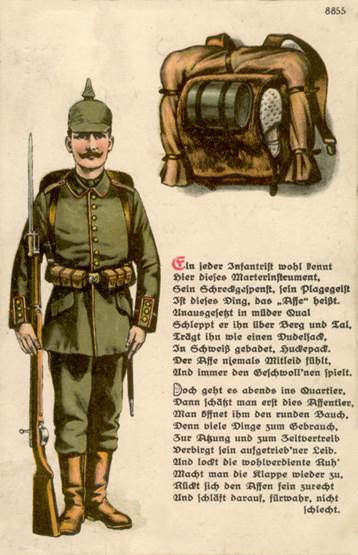
Ein jeder Infantrist wohl kennt hier dieses Marterinstrument, Sein Schreckgespenst, sein Plagegeist Ist dieses Ding, das „Affe" heisst. Unausgesetzt in müder Qual Schleppt er ihn über Berg und Tal, Trägt ihn wie einen Dudelsack, In Schweiss gebadet, Huckepack. Der Affe niemals Mitleid fühlt, Und immer den Geschwollenen spielt.
Doch geht es abends ins Quartier, Dann schätzt man erst dies Affentier, Mann öffnet ihm den runden Bauch, Denn viele Dinge zum Gebrauch, Zur Atzung und zum Zeitvertreib Verbirgt sein aufgetriebener Leib. Und lockt die wohlverdiente Ruh' Macht man die Klappe wieder zu, Rückt sich den Affen sein zurecht Und schläft darauf, fürwahr, nicht schlecht.
Each infantryman well knows this instrument of terror, its terrible specter, its annoying presence called the "monkey." Without rest, in drudgery, he drags it over mountain and valley, carrying it like a piggybacked bagpipe all soaked in sweat. The monkey never feels compassion and always acts puffed up.
At evening it goes into Quarters, where one first appreciates this monkey by opening its rounded belly because there are necessities, and food, and things one can use for leisure time activities in its bloated body. And it lures one to a well deserved rest by closing its mouth once again, and putting the monkey back on one's back to sleep and not too badly with it after all.
Many thanks to Herr Schmidt for the translation.
Click Here
to download a this photo essay on packing the Tornister
(Right click and select "Save link as" to
download the PDF to your computer)